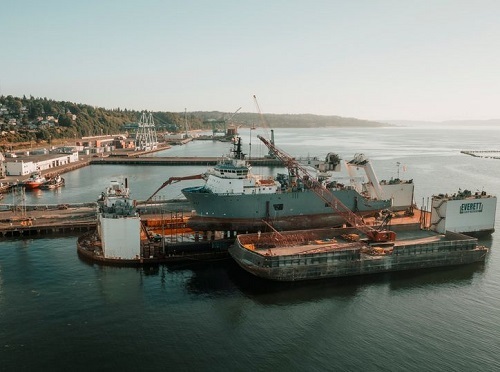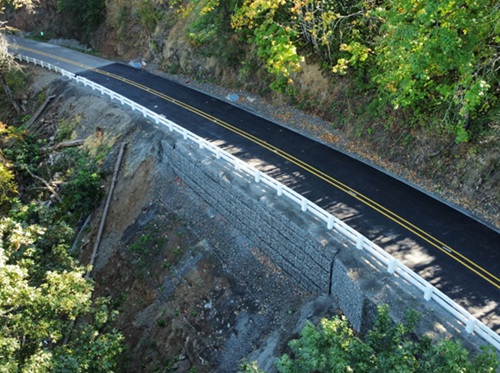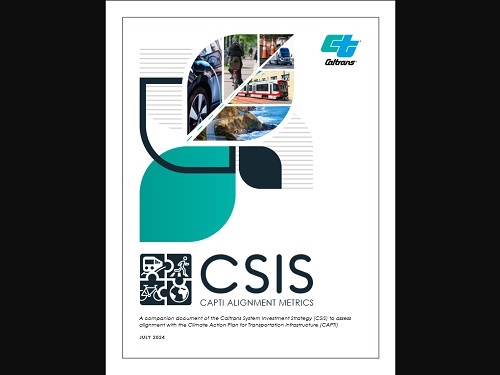The Oregon Department of Transportation recently reopened a landslide-damaged segment of a road known as American’s first scenic highway – reconnecting a century-old route enjoyed by motorists, bicyclists, and pedestrians.
[Above photo by Oregon DOT]
About 800 feet of the 73-mile Historic Columbia River Highway crosses an active section of the Larch Mountain Slide. In March, geotechnical engineers noted accelerated land-shifting that caused structural issues for the road, as well as guardrails and the embankment beside it.
Oregon DOT closed part of the two-lane road for two weeks to seal the asphalt cracks and install orange barrels along the sinking guardrail. But a longer-term solution was needed for the road – one supporting the embankment and repairing the road’s drainage system, all of which were damaged by the active landslide.
The agency’s project team faced several issues – including the mountainous terrain and environmental considerations – as they sought to finish repairs to the damaged roadway before mid-October, when the rainy season begins.
“The topography is challenging, with steep cliffs to the south, and the railroad, Columbia River, and I-84 to the north,” said Terra Lingley, Columbia River Gorge National Scenic Area coordinator at Oregon DOT. “The location of the work zone required getting crews, equipment, and heavy metal materials down a steep slope for installation.”
On July 7, Oregon DOT closed a 0.8-mile section of the Historic Columbia River Highway and started work. To repair and improve the drainage, the agency’s team employed a pully system to lower three pipe outfalls about 100 feet to the site. Crews improved the embankment’s stability by adding geo-grid mesh in layers to the wall and adding soil anchor nails and wire mesh below the wall.
Because the Columbia River Gorge is a National Scenic Area – a federal designation given to only 10 sites across the country – specific environmental regulations governed Oregon DOT’s construction efforts.
For example, the road project could not negatively affect the natural, cultural, recreational, or scenic resources in the area, Lingley said.
The project was substantially completed in late September, with just a few punch list items expected to be completed by November.
“This was a quick-build project from design, bid, construction and finish before the rainy season,” noted Jason McNeil, an Oregon DOT engineer, in a news release about this road repair endeavor.
Bicyclists welcomed the re-opening of the road, which is popular “due to the relatively gradual hills, as the roadway is no steeper than 5 percent,” Lingley said. “The waterfalls along the corridor are a large draw for folks seeking both a longer ride and to view the sights along the way.”
The Historic Columbia River Highway is one of the most honored and recognized roads in the country. It is listed as a National Historic Landmark, a National Historic Civil Engineering Landmark, an All-American Road, and is on the National Register of Historic Places.
Completed in 1922, the road was designed specifically to feature stunning views of the Columbia River Gorge chronicled by Lewis and Clark in the early 19th century. The road was immediately popular, but by the mid-20th century, railroad realignments, the need for wider and straighter highways, and the construction of I-84 left the winding, two-lane road pretty much an afterthought for most travelers.
Much of that began to change in 1986 with the signing of the National Scenic Area Act, which Oregon DOT invoked to begin rebuilding parts of the old highway for recreation purposes. The agency refurbished and rebuilt tunnels and bridges, and some parts of the road were designated for non-motorized vehicles.
Today, the Historic Columbia River Highway Trail starts in three places where the old road ends for motor vehicles, forming a full alignment that is fully accessible by bicycle, Lingley said. Bicyclists especially enjoy riding “the waterfall corridor” between Troutdale and Ainsworth State Park.
“Some folks ride the full length of the Historic Columbia River Highway…and some do a loop using county roads,” Lingley said. “In my opinion, it’s especially popular due to the views, the destinations/sights along the way, and the experience riding on a scenic byway.”
 Infrastructure
Infrastructure



